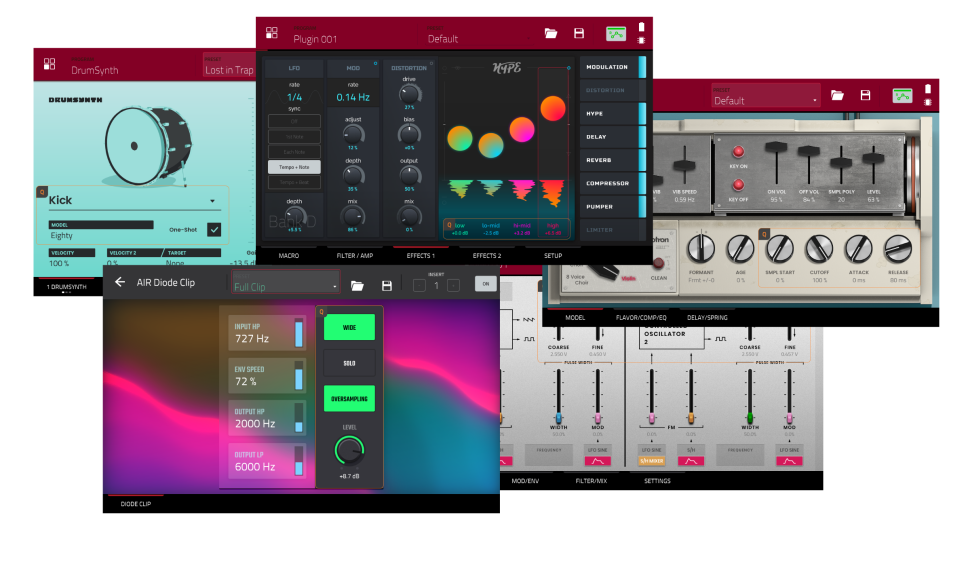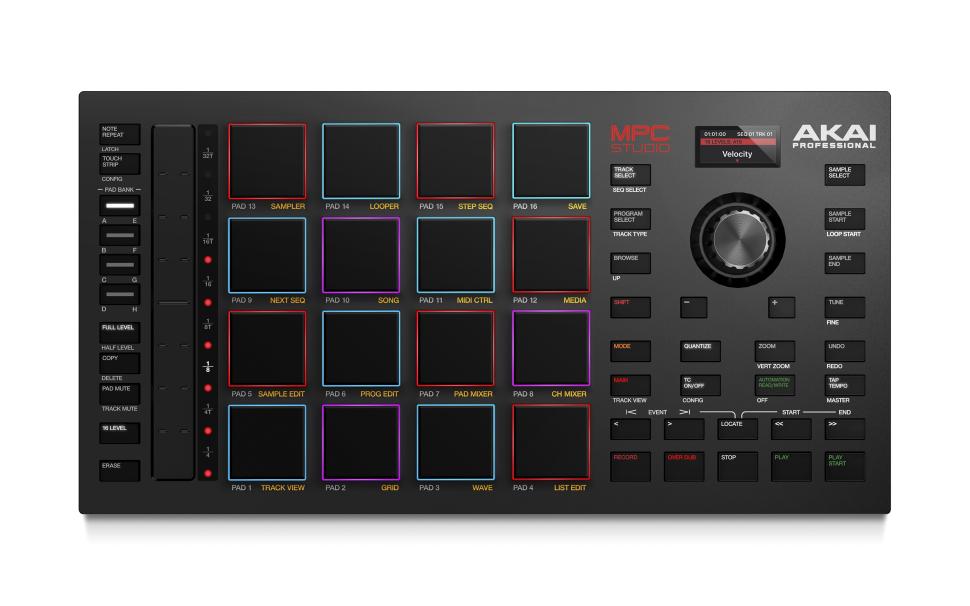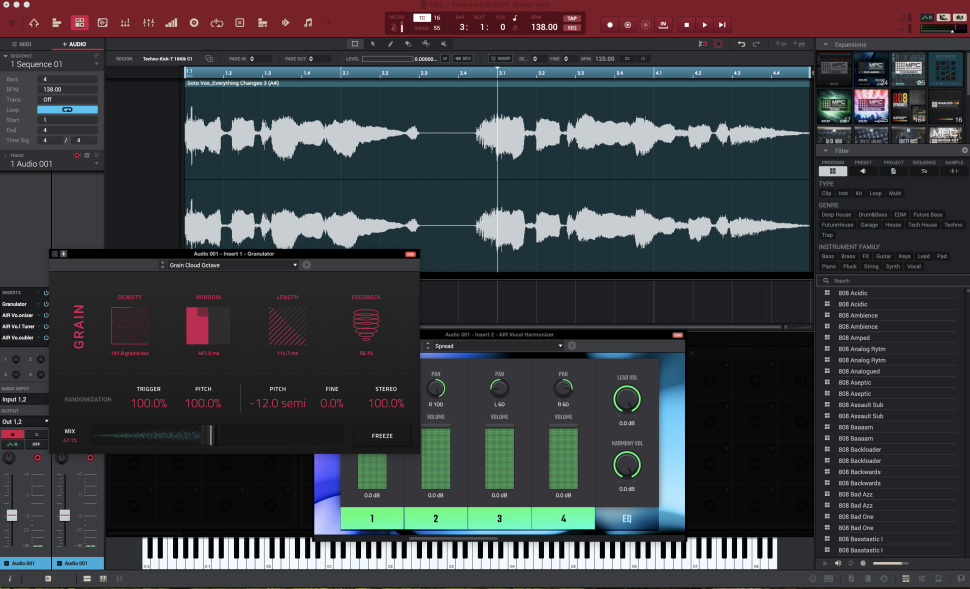Review: Akai MPC Studio & OS 2.10

After Akai has primarily taken care of the standalone devices and the MPC software in recent years, there is now a new controller again. The MPC Studio is a descendant of the MPC Studio (2012) and Studio Black (2016), but is officially not explicitly distributed as version 2. Together with the MPC software 2, the controller forms a complete production environment for beats and songs that can be used either standalone or as a plug-in for any DAW.
Equipment
In contrast to its predecessor, the four Q-Link controls have been omitted, but there is now a touch strip that can be used to control a number of parameters. More on that in a moment. The new model also has a much smaller screen, but it is now high-resolution and colored. The rest of the device is largely identical: numerous buttons for direct access to important functions, double assignments via the shift key and very responsive pads with multicolor backlight to provide information about velocity or to identify sound categories by color. Essential functions such as quantization, tab tempo, note repeat and arpeggiator, sample start and the like can be On the rear, there is only the USB port and MIDI in and out in mini-jack format.

In live use
The hardware feels absolutely valuable, is very flat with a height of 2 cm and leaves enough space for pleasantly large pads despite the compact dimensions of 33 x 17 cm. These can be played very sensitively and provide information about velocity and playing modes at any time thanks to colored borders.
The touch strip is a welcome innovation because it can serve as a mod or pitch wheel, regulate volume, trigger pads in Notes mode and control various parameters. In Q-Link mode, it takes over the function of the 16 Q-Link controls, with which, depending on the operating mode, samples and slices can be fine-tuned, areas zoomed or project settings changed.
While the direct access to modwheel and pitch bend without an extra keyboard is a great innovation, it is of course important to keep track of so many operating modes in order to get the right parameter in the end. The same applies to the OLED display, which is visually stylish but provides little information. Here we liked the approach of the old MPC Studio models better. Although the displays were only monochrome, they offered a much better overview of the song and its tracks, visible sample waveforms and much more, which made it possible to work without looking at the monitor and thus fully concentrate on the sound. The current version makes the permanent use of the monitor absolutely necessary, for example when sampling, slicing, editing sequences, loading sounds and other basic processes.
The MPC software
While older MPCs and early versions of the MPC software were still pure sequencers and samplers, all conceivable features that make a full-blown DAW are now on board. In addition to „Drum Programs“ for firing samples, there are „Keygroup Programs“ for the chromatic playback of multisamples, MIDI tracks for external tone generators, plug-in tracks for internal and VST/AU tone generators, CV channels for modular equipment (only for the MPC models One, Live mkII and X), as well as “Clip Programs” for tempo-synchronized playback of loops in the style of Ableton Live. Speaking of which: MPC projects can be exported directly as songs for Live 10 upwards at the push of a button.
It also includes up to 128 audio tracks, and automations can be recorded for pretty much any parameter. The musical input and output is taken care of by chord and scale functions, random generators for drums and melodies, a clever combination of arpeggiator and pattern player, live performance effects, as well as the countless included sounds and instruments.
An MPC is suitable for ...
First of all: The MPC does not want to be a DAW for everyone. And that is not even due to the equipment, because it is pretty complete, but mainly because of the workflow of the MPCs. This corresponds neither to a clip-based approach � la Bitwig or Ableton Live, nor to the typical timeline recording of Cubase, Logic or Pro Tools. Although the scenarios are actually contained in the software, everything here revolves around patterns, jamming, building beats, finger drumming and putting these elements together to create a song. If you have never worked with an MPC but are used to other sequencers, you should definitely allow some time to get used to it.
But once you have familiarized yourself with the pattern-based cosmos, the reward in the form of fresh ideas is not long in coming. Here, supposed limitations in comparison to large DAWs quickly become obsolete and the strength reveals itself: the focus on the beat or melody. Instead of spending hours working on small pieces of sounds, tinkering with the equalizer or laboriously optimizing melodies, the credo here is: either the idea works or it doesn‘t work. The MPC still offers the option of getting completely lost in details if you want, but the focus is on fast design. Working detached from the monitor, which puts the ears instead of the eyes in the foreground, is especially helpful here.
Verdict for MPC Studio
The robust controller not only looks stylish, it also offers a good feel when recording beats, finding melodies and hooklines, using the arpeggiator and scale mode or when firing loops and clips. In all actions concerning the playback of sounds, the new Studio is undoubtedly a stunner and can be used completely autonomously from the monitor, which is ultimately a big part of the charm when working with MPCs. However, as far as the core of the MPC cosmos is concerned, i.e. sampling, slicing and bending sounds, you can‘t get around using the mouse and monitor, because there are simply no controls for that and the mini-display doesn‘t display waveforms. We are a bit pained by the lack of four Q-Link controls, because the possibilities for live performance with a single touch strip are rather limited. On the other hand, the MPC software allows the integration of any controller, which can take over the control of parameters, if this is required at all.
In general, the MPC Studio is available for a fairly tight budget and, in combination with the MPC software and a huge package of plug-ins and sounds, offers enough material for several years of entertainment in the studio. And it is up to everyone whether the software is used as a standalone solution or in conjunction with a DAW. Despite the aforementioned shortcomings, the bottom line remains a bombastic overall package for producers and beatmakers from hip-hop to electronic sound.

The MPC update 2.10
Already with the update to version 2.9, Akai gave the MPCs a complete drum synthesizer in addition to a few fixes and minor improvements. With eight drums, superb presets and unrivaled sound. You rarely get spoiled like that. Accordingly, we were very curious about the current update to 2.10 and - this much in advance - we were not disappointed.
The latest version for the standalone software and all controller and standalone MPC models includes a suite of three new vocal plug-ins, seven new effects, four new synthesizers, support for audio interfaces, and several performance updates that almost get lost among the other new features. Both standalone devices and the MPC software with or without controller are growing more and more into an independent platform with which full-blown productions can be produced from start to finish. But one after the other ...
The vocal suite
With the harmonizer, tuner and doubler, three more plug-ins have found their way into the extensive effects repertoire, all with a focus on vocals. Like most of the already existing plug-ins, which by the way can only be used natively in MPCs and the software, these probably won‘t win any beauty contests, but are designed for practical use. And there they do exactly what is expected of them. Whether typical autotune vocals, doubled voices, whole harmonies or weird effects in extreme settings, the plug-ins do their jobs with flying colors. Recording „not-so-professional“ vocals directly into the MPC for capturing song ideas without subsequent embarrassment is just as possible as subtle post-processing of high-end recordings.
Seven other effects
With Half Speed, Stutter, Diode Clipper, Diffuser Delay, Sample Delay, Granulator and Limiter, the number of internal effects increases to a fabulous 97. A limiter already existed in the form of the Maximizer, but it is about as sensitive as Rambo and tends to distort and simply sound unattractive, so we gratefully accept the more subtle new addition.
As expected, Half Speed produces a copy of the sound that is half as fast, but offers the option of mixing it in continuously. Drums and beats in particular can be made significantly thicker if you add 30-40% of the downbeat copy. Actually unspectacular, but super helpful.
Our highlight of the new additions, however, is the Diode Clipper, which emulates a tube circuit. The results are impressive. Basically, the incoming signal is looped through a virtual tube and distorted accordingly. The inertia of the tube can be regulated by an envelope, which ensures effects that are as unpredictable as they are spectacular. If you use the plug-in with a slow envelope on a complete drumbeat, for example, the distorted part is slightly elongated and dragged in, thus creating additional groove. The infinitely variable basic sound itself is fantastic and ranges from pleasantly brisk to coarse, compressed and dirty. Awsome!
The new instruments
With Hype, Mellotron, Odyssey and Solina, a whopping four new sound generators have been added to the MPC‘s repertoire and these are anything but nice extras. Hype is more of a rompler, where only a handful of parameters and the effects can be modified, but the basic sounds are inspiring and varied, from good to very good quality. We are particularly fond of the mallets and percussions. The other three newcomers bring their very own retro touch with them, whereby the Solina and the ARP emulation Odyssey could use a little more warmth and bite. The Mellotron, on the other hand, is the second highlight as far as the instruments are concerned. The sound is absolutely authentic and brings a whole new (old) nuance into play with its choirs and strings.
More ins and outs
As far as external gear is concerned, the MPC models have been pretty open so far. Hard drives and sticks as well as any MIDI controller can be docked via USB, as long as they are Class Compliant. So almost all of them. With the current update, the doors for audio interfaces are now also open. Up to 32 channels can be used directly as inputs and outputs. A dream for everyone who prefers to mix their tracks live on the desk or who wants to record up to eight audio tracks at the same time.
Verdict
Here we can make it short: The update is free and therefore mandatory for all MPC owners. The new features are awesome, and the instruments and effects alone would easily be worth several hundred euros. The hardware models thus consolidate their unique position as a standalone solution. No other groove box offers nearly as many features. Even the smaller innovations like the pitch envelope, Note Off (see MPC Power Producer Workshop earlier in the issue) or the eight effect slots in Drum Programs are a blast for sound designers and speed up the workflow immensely.
As already mentioned, the software may not be to everyone‘s taste, but thanks to the free MPC Beats version, extensive testing is no problem. You can also check the computer‘s performance in advance here, because the operation can be a bit sluggish here and there on Retina Macs because it does not run as smoothly as you are used to from native applications. But that‘s complaining at a very high level. Either way: The update is
fully recommended.
Want more? Get more!



Subscribe to the digital edition of BEAT Magazine via Plugins-Samples.com and get more gear, in-depth workshops, reviews and 11 GB exclusive plugins and new sounds with every monthly issue!
Subscribe to Beat Magazine for only 4.99€ per month
